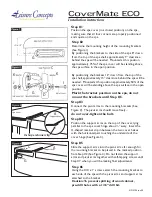
24
Northern observers/photographers have a great advantage
when it comes to performing a polar alignment. They have
the naked-eye star Polaris situated just 2/3 of a degree from
the North Celestial Pole. This makes a quick alignment of
an equatorial device like
Star Adventurer 2i
very easy to
accomplish. Just find Polaris and point
Star Adventurer 2i
so that you can see Polaris in the field of view of the
Polar
Scope
.
Unfortunately there are no bright reference stars in the
immediate vicinity of the SCP, so the procedure to obtain a
polar alignment is a bit more involved. However, there is a
small group of stars near the SCP that, while invisible to the
naked eye, can be seen in your
Polar Scope
. Once you
have this group in view, a precision polar alignment is just as
easy to accomplish in the southern hemisphere as it is in the
north, thanks to the
Polar Clock
function included in the
Star
Adventurer mini Console
.
First remove the
Polar Scope Cap
and attach the
Polar
Scope Illuminator
to the other end. This will help make the
reticule pattern in the
Polar Scope
eyepiece more visible
in dark conditions. Adjust the intensity of the illuminator by
turning the dial. Make it bright enough to see the reticule
pattern, but not so bright as to wash out your view of the faint
stars near the SCP.
The goal of the coarse polar alignment is to get your
Polar Scope
aimed near enough to the
SCP that you will be able to see a small group of four stars within its field of view. We refer
to these as the Sigma Octantis group, with Sigma Octantis being the slightly brighter of the
four, and always the one that is nearest the SCP as the group rotates about the SCP over the
course of 24 hours.
1. Setup the mount as described in
Polar Alignment in the Northern Hemisphere
.
2. Find Acrux, then following a line from it to alpha Muscae, locate the next brightest star,
gamma Muscae. If you were to draw a line through Acrux and gamma Muscae, it would point
very nearly to the SCP(see chart on previous page).
3. Raise your hand at arm length and spread your fingers so there is about an extra finger
space between each one. Put the tip of your little finger near gamma Muscae and tilt your
hand so that the tip of your thumb would be on a line that connects it to gamma Muscae and
Acrux
4. Points your
Polar Scope
into the region where the tip of your thumb has been. If you
points with reasonable accuracy, you should be able to see the Sigma Octanis group in
the field of view of the Polar Scope. If not, keep making adjustment until you can using the
altitude and azimuth adjusters on your wedge.
Polar Alignment in the Southern Hemisphere:
Performing a Coarse Polar Alignment in the Southern Hemisphere
















































